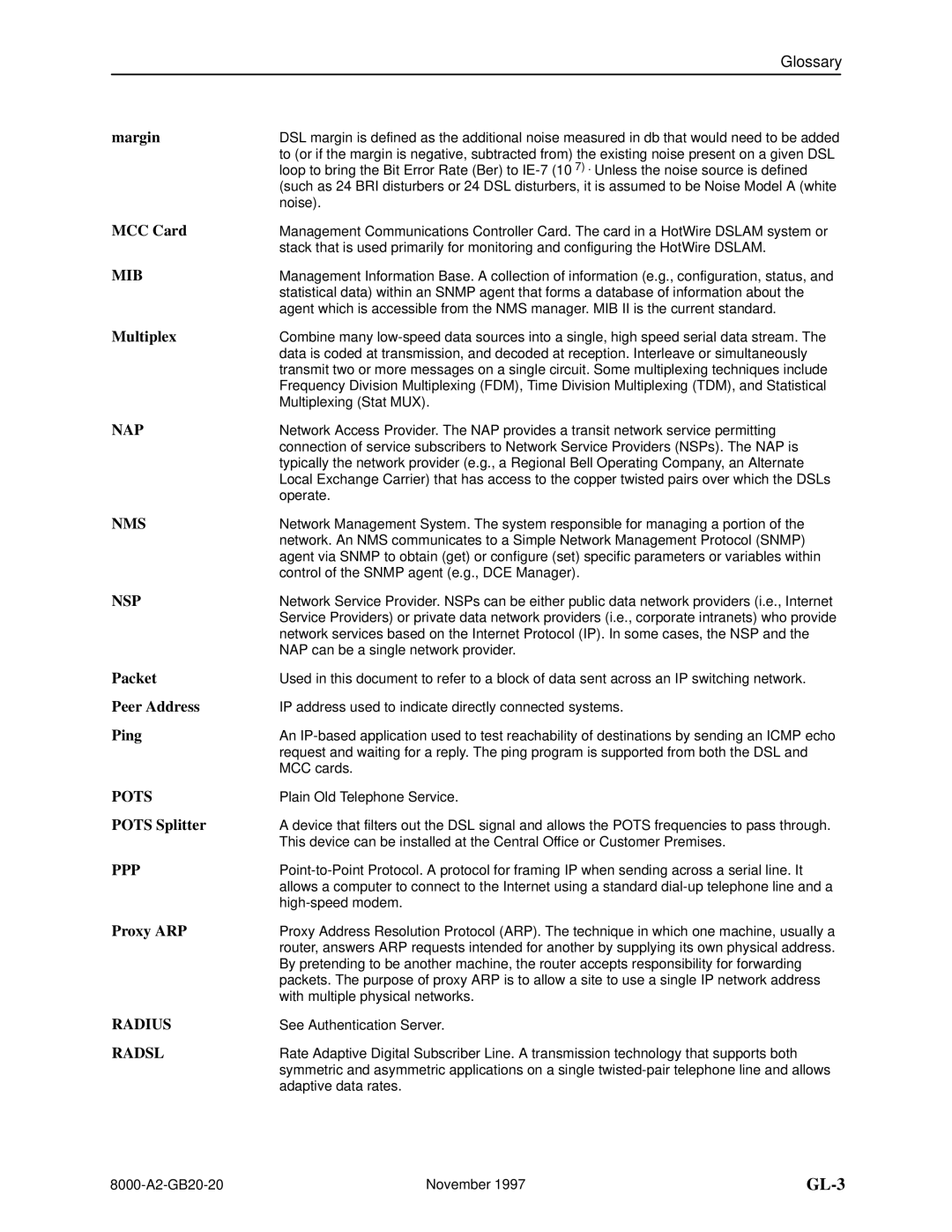Glossary
margin | DSL margin is defined as the additional noise measured in db that would need to be added |
| to (or if the margin is negative, subtracted from) the existing noise present on a given DSL |
| loop to bring the Bit Error Rate (Ber) to |
| (such as 24 BRI disturbers or 24 DSL disturbers, it is assumed to be Noise Model A (white |
| noise). |
MCC Card | Management Communications Controller Card. The card in a HotWire DSLAM system or |
| stack that is used primarily for monitoring and configuring the HotWire DSLAM. |
MIB | Management Information Base. A collection of information (e.g., configuration, status, and |
| statistical data) within an SNMP agent that forms a database of information about the |
| agent which is accessible from the NMS manager. MIB II is the current standard. |
Multiplex | Combine many |
| data is coded at transmission, and decoded at reception. Interleave or simultaneously |
| transmit two or more messages on a single circuit. Some multiplexing techniques include |
| Frequency Division Multiplexing (FDM), Time Division Multiplexing (TDM), and Statistical |
| Multiplexing (Stat MUX). |
NAP | Network Access Provider. The NAP provides a transit network service permitting |
| connection of service subscribers to Network Service Providers (NSPs). The NAP is |
| typically the network provider (e.g., a Regional Bell Operating Company, an Alternate |
| Local Exchange Carrier) that has access to the copper twisted pairs over which the DSLs |
| operate. |
NMS | Network Management System. The system responsible for managing a portion of the |
| network. An NMS communicates to a Simple Network Management Protocol (SNMP) |
| agent via SNMP to obtain (get) or configure (set) specific parameters or variables within |
| control of the SNMP agent (e.g., DCE Manager). |
NSP | Network Service Provider. NSPs can be either public data network providers (i.e., Internet |
| Service Providers) or private data network providers (i.e., corporate intranets) who provide |
| network services based on the Internet Protocol (IP). In some cases, the NSP and the |
| NAP can be a single network provider. |
Packet | Used in this document to refer to a block of data sent across an IP switching network. |
Peer Address | IP address used to indicate directly connected systems. |
Ping | An |
| request and waiting for a reply. The ping program is supported from both the DSL and |
| MCC cards. |
POTS | Plain Old Telephone Service. |
POTS Splitter | A device that filters out the DSL signal and allows the POTS frequencies to pass through. |
| This device can be installed at the Central Office or Customer Premises. |
PPP | |
| allows a computer to connect to the Internet using a standard |
| |
Proxy ARP | Proxy Address Resolution Protocol (ARP). The technique in which one machine, usually a |
| router, answers ARP requests intended for another by supplying its own physical address. |
| By pretending to be another machine, the router accepts responsibility for forwarding |
| packets. The purpose of proxy ARP is to allow a site to use a single IP network address |
| with multiple physical networks. |
RADIUS | See Authentication Server. |
RADSL | Rate Adaptive Digital Subscriber Line. A transmission technology that supports both |
| symmetric and asymmetric applications on a single |
| adaptive data rates. |
November 1997 |
|
